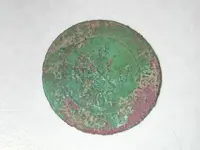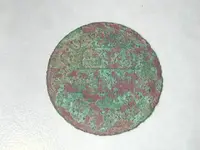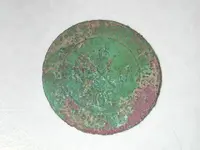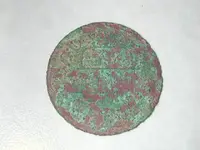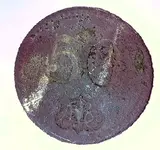This is going to be tough to attribute - it was a token made for the National Billiard Manufacturing Co. of Cincinnati, Ohio to be sold to the business on the other side for use. That is a bit confusing, but here's the story. When a person wanted to open a billiard hall and/or saloon, the capital investment was pretty high, especially if he wanted to put in new billiard tables, a new bar, etc. So many of the major manufacturing companies loaned startup money - similar to buying a new car today with dealer financing. The NBM Company (that is their logo on the first pic - the name around and a crossed set of billiard cues separating the N/B/M/Co. in the center) was one of these major manufacturers. The Brunwick-Balke-Collender Co. was another of the big ones.
Anyway, they would enter into a contract and the company would supply the fixtures to the businessman and would expect repayment over time. Along with tables, bars, glassware, spittoons, etc., the company would offer to supply tokens for use in the billiard hall. Few of the big companies actually made the tokens themselves, since they were really in the woodworking business - they contracted out to have the tokens made at a stamp works. They offered the business a pretty good price since one side of the token was devoted to advertising their product (billiard tables). The other side of the token (your second pic) was for the use of the business. To be able to supply these tokens as economically as possible, special dies were used that minimized the amount of work involved when cutting the dies. This involves standard wording and inserts for the denomination (5¢ in the case of yours) and for the name of the proprietor of the business (I can't read the name on yours, but it is on the oval section just below the 5¢). That way, only the "slug" or insert had to be made especially for this order. Since there was not much room on this insert, this type of token is almost always a maverick (i.e. does not have the town and state), and often just has the initials of the proprietor.
This type of token was popular in the 1880-1910 timeframe. If you can decipher a name in the oval area, that is a start on figuring out where the token was actually used. The Cincinnati location of the NBM Co. is not much of a clue, but since they usually marketed in the region, rather than nationally. Chances are that the token is from no farther than two states away.
John in ID
 Anyone familiar with this token ? Any help would be appreciated. I know it is hard to make out in the phots but it looks like the front say NBM Co and near the rim at about the 2 o'clock position it looks like the word manufact?. The back looks like between the 10 o'clock and 2 0'clock position might be good for and it looks like trade at the bottom . In the recess in the upper middle it looks like 5 c. I found this today in a civil war camp, not that that makes it period. I hate to over clean it.
Anyone familiar with this token ? Any help would be appreciated. I know it is hard to make out in the phots but it looks like the front say NBM Co and near the rim at about the 2 o'clock position it looks like the word manufact?. The back looks like between the 10 o'clock and 2 0'clock position might be good for and it looks like trade at the bottom . In the recess in the upper middle it looks like 5 c. I found this today in a civil war camp, not that that makes it period. I hate to over clean it.  Anyone familiar with this token ? Any help would be appreciated. I know it is hard to make out in the phots but it looks like the front say NBM Co and near the rim at about the 2 o'clock position it looks like the word manufact?. The back looks like between the 10 o'clock and 2 0'clock position might be good for and it looks like trade at the bottom . In the recess in the upper middle it looks like 5 c. I found this today in a civil war camp, not that that makes it period. I hate to over clean it.
Anyone familiar with this token ? Any help would be appreciated. I know it is hard to make out in the phots but it looks like the front say NBM Co and near the rim at about the 2 o'clock position it looks like the word manufact?. The back looks like between the 10 o'clock and 2 0'clock position might be good for and it looks like trade at the bottom . In the recess in the upper middle it looks like 5 c. I found this today in a civil war camp, not that that makes it period. I hate to over clean it. 


